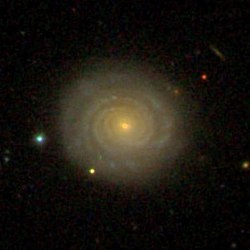| NGC 4076 | |
|---|---|
 SDSS image of NGC 4076. | |
| Observation data (J2000 epoch) | |
| Constellation | Coma Berenices |
| Right ascension | 12h 04m 32.5s [1] |
| Declination | 20° 12′ 18″ [1] |
| Redshift | 0.020728 [1] |
| Heliocentric radial velocity | 6214 km/s [1] |
| Distance | 291 Mly (89.1 Mpc) [1] |
| Group or cluster | NGC 4065 Group |
| Apparent magnitude (V) | 14.35 [1] |
| Characteristics | |
| Type | Sa [1] |
| Size | ~103,000 ly (31.6 kpc) (estimated) [1] |
| Apparent size (V) | 0.9 x 0.9 [1] |
| Other designations | |
| UGC 07061, PGC 038209, MCG +03-31-034 [1] | |
NGC 4076 is a spiral galaxy located 290 million light-years away [2] in the constellation Coma Berenices. [3] The galaxy was discovered by astronomer William Herschel on April 27, 1785 [4] and is a member of the NGC 4065 Group. [5] [6] [7] [8] [9] [10] [11] [12]
NGC 4076 is classified as a LINER galaxy. [13] [14]
NGC 4076 has been host to two type Ia supernovae. [15] [16] The first, SN 2007M was first observed on December 24, 2006. [15] [17] [18] However, it was discovered on January 14, 2007. [18] [19] [20] The second, SN 2011bc was discovered on April 1, 2011. [15] [21] [22] [23]